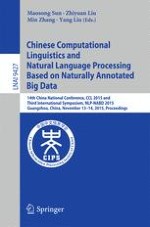2015 | Book
Chinese Computational Linguistics and Natural Language Processing Based on Naturally Annotated Big Data
14th China National Conference, CCL 2015 and Third International Symposium, NLP-NABD 2015, Guangzhou, China, November 13-14, 2015, Proceedings
Editors: Maosong Sun, Zhiyuan Liu, Min Zhang, Yang Liu
Publisher: Springer International Publishing
Book Series : Lecture Notes in Computer Science
